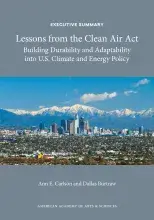Lessons from the Clean Air Act
Climate and energy policy needs to be durable and flexible to be successful, but these two concepts often seem to be in opposition. The Clean Air Act, first passed by the United States Congress in 1963 with amendments in 1970 and 1990, is a venerable, living institution that embodies both traits and, as a result, has been hugely successful in improving the environment. Its programs reach across the entire economy, regulating various sectors and pollutants in different ways. This illuminating book examines these successes—and failures—with the aim to offer lessons for future climate and energy policymaking in the United States at the federal and state level. It provides critical information to legislators, regulators and scholars interested in understanding environmental policymaking.
This executive summary is based on Lessons from the Clean Air Act: Building Durability and Adaptability into U.S. Climate and Energy Policy, available from Cambridge University Press at https://www.cambridge.org.
To Bob Fri (1935–2014), our intellectual leader on this project and our dear friend.
